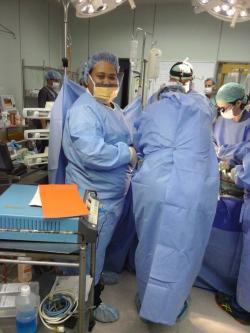Perioperative Leader - Natasha Mamea, Samoa

The WHO CC UTS acknowledges use of key language from The WHO Global Strategic Directions for Nursing and Midwifery (2021–2025).
Surgical site infections remain a significant contributor to postoperative morbidity and mortality, including the threat of antimicrobial resistance (AMR). Infection control and prevention in perioperative settings or around the time of surgery is critically important to decrease the risk of perioperative infections [1].
Natasha Mamea is the critical care senior nurse specialist who has been actively involved in raising nursing and midwifery standards in Samoa and across the Pacific. She currently leads operating theatre at the Moto'otua Hospital in Apia, the capital city. The Moto’otua Hospital serves a population of 200,000 or 60 percent of the Samoan population.
Natasha has spent the past four years engaged with the implementation of new perioperative care standards, particularly in relation to infection prevention and patient safety. Her interest in this area started following her involvement in the implementation of the Pacific Perioperative Practice Bundle and audit tools in 2015. As a part of the project, she underwent several training sessions along with nurses and midwives from 14 Pacific Island Countries (PICs).
We all met and were all trained on the standards. Each island leader was supported to do their own implementation plan and train their own nurses,
she says.
Recognizing the threat of perioperative infections and the risk of AMR, Natasha was eager to ensure that the perioperative practice standards are adopted in her hospital. The implementation wasn’t easy due to challenges such as staff shortages, limited hospital resources, and infrastructure-related issues. However, through initiatives such as use of checklists, area demarcation, posters, and audits they were able to demonstrate early improvements.
“We’ve managed to identify our weaknesses. Initially there were not enough scrubs for the nurses and doctors, and they didn’t have appropriate theatre shoes or goggles. We have managed to get some resources that were not provided previously,”
she says.
To ensure greater cooperation among PICs, the Pacific Islands Operating Room Nurses Association (PIORNA) was started in 2019. "The idea was to have the Pacific islands practice consistently with the perioperative nursing practice,” she says. Natasha is the current President of PIORNA.
Mamea says the standards have since been adopted by all 14 Pacific Islands. At the initial workshops, each island worked out how they were going to train their nurses.
The idea was to have the Pacific islands practice consistently with the perioperative nursing practice,
she says. The Perioperative Nurses Association for the Pacific has also been formed.
But unfortunately, since October 2019, Mamea and her teams have been busy with a measles outbreak on the island. Around 100 plus cases have been admitted and discharged, and they’ve seen and sent home more than 500. She says they currently have staff constraints but are supported by Australian medical staff.
Mamea has a long association with Australia. She has attended conferences in Australia and recently had a clinical attachments at Sunshine Coast Hospital. In 2009, she attended Leadership Awards at the University of Technology.
Mamea gave feedback on the original audits done by the RACG surgeons. She has also run on-the-job training and presentation sessions about the standards.
This busy senior nurse specialist has also worked as a mentor. This year, one of her innovations was inviting nurses from an eye clinic on the main island in Savai’i into the Moto'otua operating theatre.
The nurses usually work out of a small clinic in their hospital. “We are looking at developing that small theatre so they can do more emergencies in the bigger islands,” she says.
Health care in Samoa is free for pregnant women, children and adults on the pension. The rest of the population has to pay. Mamea says families usually take sick people to traditional healers, or get financial support from family. She says while health care is not expensive, medication is.
Consultations with the doctor is only $10. But if they go to pharmacies that’s where they have to pay more, depending on the drug that they are given. If they have operations, the operations are not really charged, but the admissions in the ward gets charged with $30 a day.
Most people can afford it, and it doesn’t really compare to the fact that the resources used to cater for these things are really, really expensive. I think that this is why the hospital is delayed in getting the resources.
Overall, Mamea says the quality of care is “fair and good in general” as most of the guidelines for care are based on Australian and New Zealand models.
1. Lapierre L, A.G., Vergara C, Cornejo J., Antimicrobial resistance control strategies: a coordinated research initiative experience in the Asia Pacific Region. 2017.
